Mercedes sells two EQEs.
One of them is an electric sedan (reviewed here) and the other an electric SUV. They don’t look the same but they’re both named EQE – which is kind of like naming a pair of fraternal twins Jack and Jack.
It can be a little confusing.
But though they’re related, they’re also different – even though they’re both about the same size and use the same electric drivetrains.
What It Is
The EQE is the SUV version of the EQE sedan – or vice-versa, depending on how you prefer to look at it. Both are mid-sized electric vehicles that have the same standard and optional drivetrains.
So what’s different – other than shape? 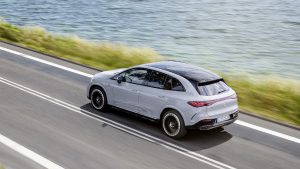
Well, the EQE – being shaped like an SUV – has almost 60 cubic feet of cargo carrying capacity with its rear seats folded (and more than 18 cubic feet behind them, when they’re in use) vs. much less than that in the EQE sedan’s trunk.
It also has a bit more rearseat legroom, too.
But it’s also several hundred pounds heavier – and for that reason, doesn’t go as far on a charge as its lighter (and aerodynamically smoother) sedan sibling.
And its price to start is higher – $77,900 for the rear-drive EQE 350+ SUV vs. $74,980 for the 350+ (and rear-drive) version of the EQE sedan.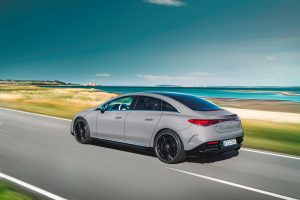
However, you can get an EQE 350 SUV with all-wheel-drive for the same $77,900 as the same thing in a different shape – the EQE sedan with all-wheel-drive, which also stickers for $77,900.
A top-of-the-line EQE 500 SUV (which comes standard with all-wheel-drive) lists for $89,500 vs. $85,900 for the same thing in the shape of a sedan.
What’s New for 2023
The EQE SUV is Mercedes’ newest electric vehicle.
What’s Good
More room for things as well as people vs. EQE sedan.
It can pull up to a 3,500 lb. trailer.
Doesn’t seem to lose charge as quickly as some other EVs.
What’s Not So Good
Maximum fully charged range is only 279 miles.
If you opt for AWD, the range goes down to 253 miles.
Like all EVs, it takes a long time to charge – at home. And the alternative – a commercial “fast” charger – means you’ll be spending more time away from home.
Under The Hood
The EQE’s power storage source is a 90.6 kilowatt-hour lithium-ion battery. It feeds power to one – or two – electric motors, depending on whether you choose rear-drive (and just one motor) or all-wheel-drive (two motors).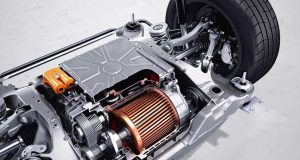
There is no transmission – which is one of the ways EVs save some weight (and cost) – which is good, because this helps to somewhat compensate for/defray the cost (and weight) of the battery pack. To get a sense of how much weight these add to an electric vehicle, weigh the 5,300 lb. rear-drive EQE vs. the 4,608 curb weight of the slightly larger (and non-electric) Benz GLE 350.
The GLE is about 800 pounds lighter. That’s roughly how much battery weight the EQE has to lug around.
The good news is that EV electric motors make all this weight feel light. The rear-drive EQE350’s single 288 horsepower motor doesn’t sound particularly powerful – until you take into account the 417 ft.-lbs. of torque this motor produces – as soon as you ask it to. Because it’s not an engine, there’s no waiting for the revving that would be necessary – with an engine – to get the torque that gets you moving. It’s why the rear-drive EQE 350 can get to 60 in less than six seconds – even though it weighs almost as much as a Chevy Suburban (5,616 lbs.)
The AWD-equipped EQE has the same rated horsepower, but advertised torque increases to 564 ft.-lbs.
However, the electric Benz’s range decreases from the rear-drive version’s 279 miles to just 253 miles.
The strongest version of the EQE SUV – for now – is the EQE 500, which comes with two more powerful motors that, combined, produce 402 horsepower and 633 ft.-lbs. of torque. Interestingly, this strongest and heaviest (5,665 lb.) version of the EQE SUV has a bit more range (269 miles) even though it is heavier than a Chevy Suburban.
It can also get to 60 in 4.4 seconds, which is several seconds quicker than a V8-powered Suburban.
The power (and immediate torque) of electric motors belies the weight of electric vehicles – insofar as acceleration.
But there’s no getting around entropy.
It takes a lot of energy to get 5,300-plus pounds of anything moving, especially quickly. But electric vehicle battery packs don’t store very much energy. To be precise, they store the rough equivalent of about half a tank of gas, or about seven gallons. That would be enough to get a non-electric SUV about the same size as the EQE that averaged say 30 miles-per-gallon about 210 miles down the road. That’s not very, either. But keep in mind – that’s only half a tank of gas. A non-electric equivalent such as the Benz GLE can go more than twice that far because it can carry about twice as much gas (and so, energy) as half a tankful.
For an EV to be able to go that far, it would need a larger – and even heavier – battery pack to store the necessary energy. But that would push the weight of an EV like the EQE to more than 6,000 pounds – and it would burn even more energy to move all that weight.
You see the problem.
Which isn’t even range problem, per se. The tandem problem is the time it takes to get that range back.
Especially at home – where the “fastest” you can recharge an EV is Level II, using a 240V outlet. That takes 8-11 hours to recover a full charge. If you haven’t got a 240V outlet and use a standard 115-120 volt household outlet, it will take more than a day to recover a partial charge.
I spent a lot of time waiting (at home) for the EQE to charge. I could have spent less time at a “fast” (Level III) commercial charger, but the problem there is having to drive there – and back – which takes away time from being at home as well as from driving.
This would be less of a problem if the range were at least as much as is typical for a non-electric equivalent rather a half to a third less far. But that would necessitate a larger (heavier) battery and . . . well, you see the problem.
It’s obviously not as much of a problem for people who mostly drive short distances and so usually have plenty of charge left – and for that reason, aren’t forced to wait. But if your daily drive is 50 miles or more, you may find – as I did – that you are spending a lot of time waiting to be able to drive, again.
There is some good news, though, as regards this EQE. Unlike a number of other-brand EVs I have test driven over the past year, this one seems to go about as far as Mercedes (and the dashboard range indicator) says it will. Not quite – but that’s probably due to my heavy right foot. Even so, I found that if I drove 50 or so actual road miles, I only used up about 60 indicated miles.
Some other EVs burned through their indicated range as if they had a leak in the proverbial (and non-existent) gas tank.
But when you use up even 60 miles of range and only had 150 miles of range to start with (because you maybe didn’t have time to wait for a full charge) you’re not far from running on empty. And because this is an EV, you can’t just roll into the next gas station on fumes – and be back on the road in minutes.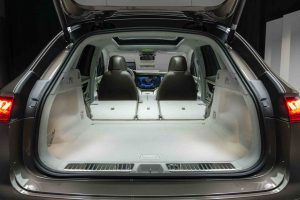
At The Curb
Being an SUV, the EQE benefits from the attributes that have made SUVs much more popular than cars, which they’ve all-but-replaced.
The chief attribute being room – and here we have an interesting study in contrasts.
The EQE SUV has 18.4 cubic feet of cargo space behind its second row – which is more than the EQE sedan has, period – because the latter only has a small trunk for stuff. It can’t be expanded to accommodate more stuff, either. But in the EQE – like most SUVs – you can fold the rear seats down and more than double the available cargo space to 59 cubic feet. This endows the EQE SUV with the ability to carry stuff and people.
It shares with the EQE sedan flush-mount door pulls that extend when the key holder approaches and with the EQS sedan (Mercedes’ top-of-the-line electric sedan) what appears to be a single large LCD touchscreen that combines the main 12.3 inch driver’s instrument cluster with the secondary 12.8 inch screen for the apps – vs. the physically separate, two-piece displays in the EQE sedan.
All of these can be a bit much to use while driving but this is remedied by Mercedes voice-assist tech. Just ask the car – Hey, Mercedes! – to change the station to the one you want, adjust the heat or AC or call up the GPS map.
At close to $80k to start, the “base” EQE 350 is kind of like a starter estate home. You expect things like granite countertops and Andersen windows are part of the deal. Similarly, here, things like a 15 speaker audio system and a power sliding full-length panorama sunroof are standard.
Aber, the lowest-priced EQE does not come standard with real leather seats. You have to step up to the Pinnacle trim for those.
Otherwise, it’s Mercedes synthetic leather seats – which (unlike like say synthetic meat) actually do look and feel convincingly real. Also included with the Pinnacle is an augmented reality navigation system, multi-pixel LED headlights, a heads-up display and Mercedes’ Air Balance cabin scent system. Open the glovebox and you’ll find a small glass jar of scent – you can pick from several. This is background misted into the cabin.
Perhaps the most desirable option, though, is the available driver’s seat/front passenger seat massage system. Mercedes offers one of the best such systems on the market in that the massage rollers are powerful enough that you actually do get a massage.
The Rest
The EQE has its charge port located on the passenger side rear quarter panel, which means you may have to back-up to get close enough to for the charge cord to reach wherever your plug (at home) is. Be aware that you can’t use an extension cord – because the factory supplied charging apparatus will detect impedance and disallow the charge.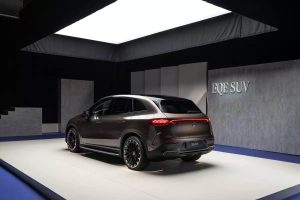
Another awkwardism is the location of the 12V power point – which is tucked up on the passenger side of the center console where it cannot be seen (or reached) unless you squat down and look for it. This makes it difficult to plug in accessories such as radar detectors.
As of this writing there isn’t an ultra-performance AMG iteration of the EQE SUV.
But it is probable one will be available soon.
The Bottom Line
Both EQEs are posh, powerful but short-leashed vehicles.
Until more energy can be stored in EV batteries (without making EV batteries even heavier and more expensive than they already are) or a way can be divined to get one off the charger much faster, the market for these and other EVs will be limited to those who can afford the wait, don’t drive much – or are affluent enough to have a second vehicle available to drive while their EV charges up.
. . .
If you like what you’ve found here please consider supporting EPautos.
We depend on you to keep the wheels turning!
Our donate button is here.
If you prefer not to use PayPal, our mailing address is:
EPautos
721 Hummingbird Lane SE
Copper Hill, VA 24079
PS: Get an EPautos magnet or sticker or coaster in return for a $20 or more one-time donation or a $10 or more monthly recurring donation. (Please be sure to tell us you want a magnet or sticker or coaster – and also, provide an address, so we know where to mail the thing!)
My eBook about car buying (new and used) is also available for your favorite price – free! Click here. If that fails, email me at EPeters952@yahoo.com and I will send you a copy directly!


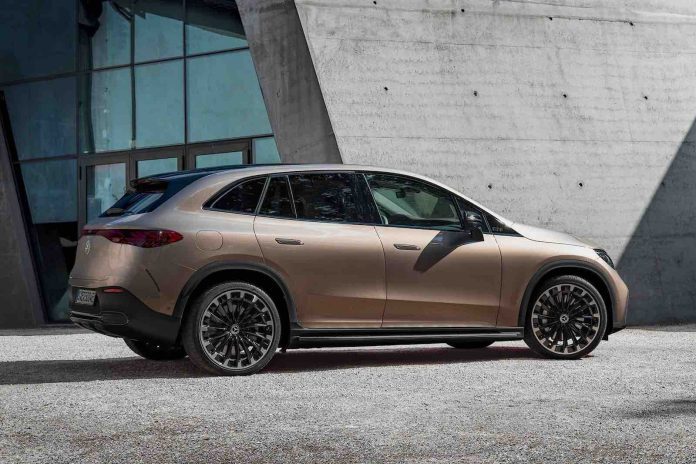

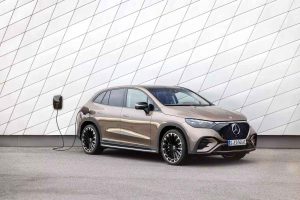
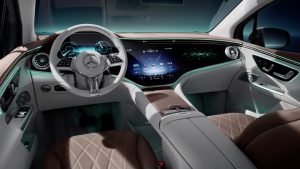


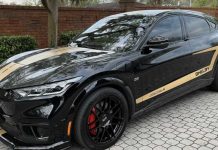





Just, don’t EVen.
https://www.youtube.com/watch?v=SIpXkQhq1ps
BTW, Estimated $1M in damages to the home. Well, it reduced their ‘carbon footprint’ at least, right?
Of course, it all went up in flames, smoke, CO, CO2, hydrozine, methelyne-chloride, and every other nasty chemical reaction you can name.
Guess that was really good for the atmosphere, wasn’t it?
I just saw the video, Graves –
And I had that same car in my driveway just a few weeks ago!
Eric:
Bet you are glad you kept it in the driveway!
Morning, Ugg!
Indeed – and far away from the garage! I will not park an EV near enough to my house to risk losing my house. Some inside baseball: I was supposed to be getting an electric “motorcycle” to review. The manufacturer pulled them from the press fleet. I wonder how come…
You can’t make this stuff up
https://www.reuters.com/investigates/special-report/tesla-batteries-range/
The article referred to ‘range anxiety’. People have no clue about range “reality” until they find out they won’t get there! I’m glad all of these ‘smart’ people chose to be guinea pigs so the rest of us can see what a scam EVs are.
Is the Mercedes Hecho en Alabama?
Before Tesla Model X became the stay-at-home-Mommy grocery getter of choice around here, the “it” vehicle was the BMW X5 which had the added appeal/snob factor for the vapid of being able to pick “their” car at the factory during a summer road trip to DC through South Carolina. I wonder if the same is true of the EQE if it is made here.
A stretch of road near my house used to be the death zone for the X5. I’m not sure why, but I would see one broken down, the owner waiting for a tow, at least once every six months.
Not only does it only take 200 child-days to mine the ore for the battery, it also provides two other child laborers jobs to disassemble the packs when they are used up.
Spotted over at Ars Technica, the electric Miata (maybe):
https://arstechnica.com/cars/2023/07/the-next-mazda-mx-5-miata-might-be-an-electric-vehicle/
On one hand, a lightweight two seater makes sense as an EV. On the other, it would be the antithesis of what the Miata is about.
An electric Miata would be like a photo of a good-looking woman you don’t even know. An image, with no reality – no emotional or physical connection.
An electric Miata?
Man, you guys are creeping me out. That’d be like an electric MGB ragtop turned into a forklift.
That ‘car’ is actually laughable. It’s a recliner. Massaging seats, big screens, mist in the air. Lean back and watch the show. Hey Mercedes (Alexa), tell me when we get there.
All EV’s are stupid, stupid, stupid. They are a waste of time, money, resources for consumers and the car companies.
Who in their right mind would buy a vehicle like that, or any other EV?
Hi Elaine,
I agree… but that’s just me!
Well, and you…
I forgot to mention. For that kind of money, not even real leather seats?
I guess I’ll just have some Cheez-It’s—now where is my wig? Entertain yourself with Carlee Russell, the black girl that ‘disappeared’ here in Alabama then showed up 48 hours later. Her story is hilarious. Hope they bring charges against her too.
“Who in their right mind”
That, right there ^ !
Would it be fair to say, ~ 40% of everyone else around us is Not in their right mind?
I tend to agree. All these additional gadgets that today’s cars are equipped with, such as enormously big touch screens etc. have some utility, but they make contemporary cars too expensive. It is also very expensive to repair these electronic gadgets, and there is no standardization, which makes repair and replacement even more costly.
I suspect that the manufacturer actually on purpose include a lot of additional electronic gadgets, so that they can earn a lot of money, when the gadget breaks down and needs repair.
I agree, Jone –
Interestingly, these electronic gadgets are cheap to install – one of the few things about new cars that are. But – as you’ve noted – repair (replacement) costs can be exorbitant. And of course, they are only “the latest thing” for about two years…
I am curious. What makes this an SUV and not a crossover? I reckon you wouldn’t take this off-roading.
In my mind, body-on-frame construction.
In Eric’s mind…good question!
Hey Publius,
From this site, what I believe I have learned that an SUV is, like you say, built on a frame, and basically a pickup truck that has been fully enclosed. A crossover, meanwhile, is essentially a car with SUV-like features.
So it begs the question, why is this an SUV? Like all modern electric vehicles, I’m sure it’s a body built upon an electric “skate”. You can put a car or truck body upon that, and the type of vehicle is mainly a function of appearance. I’m guessing it is up to the manufacturer if they want to call it an SUV, a crossover, or a chimichanga.
If you buy an electric vehicle, you’ll be buying more electricity and not much gas.
If you buy a utility that generates electricity, others will buy electricity while you are paid dividends from the shares you own of the equity.
When Three Mile Island had some problems, Consolidated Edison was selling at 2.875 USD per share, they pulled out of it and ConEd is 97 dollars per share. High price for a utility.
Tokyo Electric Power (TEPCO) is having ongoing problems with Fukushima. 9501.T is 3.53 USD per share today. 141 Yen to a dollar, the Yen is a buy along with TEPCO. 141×3=423, 423 plus 71 totals 494 Yen per share of TEPCO.
Tokyo has a stable population and plenty of industry, so TEPCO is a bargain buy on the exchanges.
15,000 shares of TEPCO will be a better investment than some worthless 50,000 dollar EV.
Yesterday was National Moon Landing Day.
This looks like something Toyota should be building. Just horrendously bland looking from every angle.
I guess that enormous Mercedes emblem makes it appealing.
If you had shown me the bubble-shaped vehicle in the top photo before I read this post, I would have guessed it to be some generic crossover selling in the $40,000 range — just a Prolemobile with fancy wheels.
Mercedes Benz cars were always porky on the scale, but never bland. Take this W06 SSK 710 Black Prince, for instance — the Challenger Black Ghost of ninety years ago:
https://tinyurl.com/ef67973v
To build such a distinctive looking vehicle today is illegal. Prison planet, innit.
Now the three points of the Mercedes-Benz star represent Diversity, Inclusion and Equity. And the ‘Q’ in EQE is a nod to our queer breth … errr, co-inmates.
The 300D defines bland. But in a good way – not 2.0 four crossover way.
Still. Bland.
I just had to turn down a drone mission because the equipment the company wants me to use has been downgraded to end-of-life status. It still flies but the app that it uses is no longer available in the various app stores and won’t be getting bug fixes or other updates. I still have the app on my phone so technically I can still use it, but imagine if something should happen and I damage property or harm someone? What do you think the insurance company will say about me flying equipment that’s officially EOL? I asked if the client was OK with me using more modern equipment and the answer was negative.
I mention this because cars are computers now, and much more complex than the simple microcontroller-based ECMs of the past. My Cherokee has had two software related recalls since 2016. There’s another one that I have scheduled for end of next month (geez, are dealer service departments even trying anymore?). How long will Chrysler continue to fix bugs? In the case of EVs the entire vehicle depends completely on the computer running the show. The motor windings are pulsed by an electronic speed controller, which gets its orders from a PCM control signal from the drivetrain management computer (can’t call it an ECM).
Will Mercedes-Benz continue to sqash software bugs for 20 years? Or will they just say that the vehicle is EOL and therefore no longer supported by the factory? My drone is seven years old, but they age worse than dogs so it feels ancient at this point. I completely understand why the manufacturer isn’t incentivized to keep it flying, but without releasing source code or allowing alternative firmware to be loaded once they say it’s done, it’s done.
And will they take the John Deere approach & say everything is proprietary bc of the end user agreement. Hence, you can’t work on your own car nor take it anywhere except the stealership.
That’s pretty much what happened with Volkswagen (VAG group). Someone cracked the Audi/Volkswagen ECM and released software that would allow owners (end users?) to modify parameters in the engine but also things like changing the stored value that told the computer what type of stereo head unit was installed, so if you wanted to add on naviation later you could. Of course if you did and took it to the dealer any waranty was instantly voided. It got to the point that the first thing dealers were instructed to do was connect up the diagnostic computer, which would then phone home to the factory to compare the config to what left the factory based on VIN.
Mercedes can’t squash bugs for five minutes, let alone 20 years. I have quipped many times here that German car makers are only one step above Lucas in electrics. Well, when it comes to software, the Germans ARE the Lucas of that world.
We pretend we still have the freedom to travel, and they pretend to give us choices
Here’s Edmunds cheapest EV’s for 2023
Chevy Bolt $26,600 259 mile range
Nissan Leaf $28,040 149 mile
Mini Cooper $29,900 110 mile
The prices are listed as starting price. So in actuality you will pay a lot more. And with current interest rates a 5yr. Loan is over $500/month for any of these. I don’t see how they are going to sell these cars?
Eric,
A very fair review of the EQE.
Are your reviews carried anywhere in the MSM at all?
If they do build an AMG model do you thing the builders of the motors will sign them in the way they did after building an actual engine? They probably won’t even need skilled craftsmen to build them anyway.
Gearheads have always looked down on the guy who thinks he can brag about using his high dollar supercar to beat handbuilt performance cars. Now I hear people touting how high performance this or that EV is. I like to ask, how fast do you think I could go if I mounted a car to a giant slingshot like an aircraft carrier has? Would that be cheating? I could then launch said “racecar” and beat ANY AUTOMOBILE. The aircraft carrier catapult gets to 165mph in 2 seconds. It is no feat to use an electric slingshot that charges all day to beat an Internal combustion engine powered vehicle. They can keep their external combustion EVs. ICE vehicles come with a “powerplant” which is a term you don’t hear as much these days unless it includes some garbage about “carbon.”
Hi Mtm,
I can’t see any point to signing an electric motor – in part because it’s not even visible. You’d have to take the EV apart in order to see it. And even if you could, what’s the charm? A motor has a few moving parts; any idiot can put one together. It is not like the fine attention to detail that goes into building an engine by hand.
As far as the rest: I’ve driven a lot of EVs; some are very quick. All of them are very boring. I liken the experience to riding in a high speed elevator. The first time, it’s kind of interesting. By the third or fourth time… who cares?
I’ve never felt that way about my ’76 Trans-Am, which I’ve been driving for 30 years. Or, for that matter, about the ’23 Challenger I was driving last week.
$77,900+ for an EV SUV? Mercedes or not that is mortgage level payments.
Way out of my price range. I bought my 2018 ICE Mazda3 in 2019 (new vehicle) for $19,000. Even that was pricey for my sorry lack of income. Guess I will drive my Mazda3 until it dies or becomes unfixable for lack of Chinese parts and mechanics.
If I am going to pay close to $100,000 for an EV vehicle it better be the size of my house where I can live in it, seeing as I am going to need a 30 year mortgage to pay for it.
I hear you, Pug!
These EVs are luxury items – even the (cough) “entry level” models. They typically sell for around $50,000. Who has that kind of money to spend on a car? Not most people.
And I think that’s basically the point.